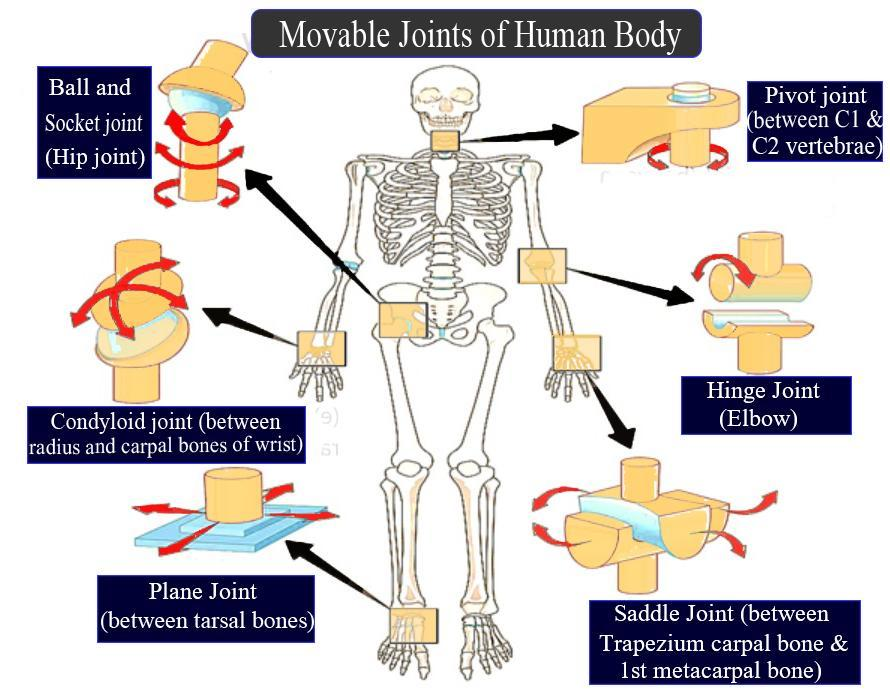
Ball and socket joint is present in
(a) Wrist
(b) Fingers
(c) Neck
(d) Shoulder
Answer
572.1k+ views
Hint: Ball and socket joint is present in this place helps in the rotation of our arm in a circular manner. Generally, we will carry a bag using this part of our body and it helps in lifting and carrying.
Complete answer:
Ball and socket joint: Ball and socket joint is a class of synovial joints. The curved surface of one bone interacts with the dent surface of the other bone providing maximum freedom of movement in all possible directions than the other type of joints.
The rotation of the shoulder, the rotation of your hip is made possible by the ball and socket joint.
Example: The spherical femur bone interacts with the pocket shaped acetabulum of the pelvis.
- A place where two bones contact and join with each other is called a joint and helps in bringing about various movements of our body. The joint type present will decide the nature and the extent of our body movement. We can walk, we can run, we can write, speak, etc., which are all made possible only because of the involvement of various joints present in our body.
- Joints are classified depending on their structural and functional aspects.
Structural classification of joints:
Structurally joints are classified into three types.
- Fibrous joints
- Cartilaginous joints
- Synovial joints
The following table gives the structural classification, nature of movements along with the examples of these joints.
Functional classification: Depending upon the nature and extent of movement, joints are classified into ball and socket joint, pivotal joint, hinge joint, condyloid joint, gliding joint, and saddle joint.

So, the correct answer is, ‘(d) Shoulder’.
Note: Arthritis is cartilage damage in joints. Shoulder arthritis occurs as the cartilage begins to break down on the side of the shoulder joint ball and/or socket. Shoulder arthritis symptoms can include shoulder joint pain, stiffness, and decreased range of motion.
Complete answer:
Ball and socket joint: Ball and socket joint is a class of synovial joints. The curved surface of one bone interacts with the dent surface of the other bone providing maximum freedom of movement in all possible directions than the other type of joints.
The rotation of the shoulder, the rotation of your hip is made possible by the ball and socket joint.
Example: The spherical femur bone interacts with the pocket shaped acetabulum of the pelvis.
- A place where two bones contact and join with each other is called a joint and helps in bringing about various movements of our body. The joint type present will decide the nature and the extent of our body movement. We can walk, we can run, we can write, speak, etc., which are all made possible only because of the involvement of various joints present in our body.
- Joints are classified depending on their structural and functional aspects.
Structural classification of joints:
Structurally joints are classified into three types.
- Fibrous joints
- Cartilaginous joints
- Synovial joints
The following table gives the structural classification, nature of movements along with the examples of these joints.
| Structural classification of joints | Nature of these joints | Examples |
| Fibrous joints | Non-movable joints | The rib cage, upper jaw, the backbone |
| Cartilaginous joints | Partially movable joints | Spinal cord |
| Synovial joints | Highly flexible joint | Neck joint, shoulder joint, knee joint |
Functional classification: Depending upon the nature and extent of movement, joints are classified into ball and socket joint, pivotal joint, hinge joint, condyloid joint, gliding joint, and saddle joint.

So, the correct answer is, ‘(d) Shoulder’.
Note: Arthritis is cartilage damage in joints. Shoulder arthritis occurs as the cartilage begins to break down on the side of the shoulder joint ball and/or socket. Shoulder arthritis symptoms can include shoulder joint pain, stiffness, and decreased range of motion.
Recently Updated Pages
Master Class 12 Business Studies: Engaging Questions & Answers for Success

Master Class 12 Economics: Engaging Questions & Answers for Success

Master Class 12 English: Engaging Questions & Answers for Success

Master Class 12 Maths: Engaging Questions & Answers for Success

Master Class 12 Social Science: Engaging Questions & Answers for Success

Master Class 12 Chemistry: Engaging Questions & Answers for Success

Trending doubts
What are the major means of transport Explain each class 12 social science CBSE

Which are the Top 10 Largest Countries of the World?

Draw a labelled sketch of the human eye class 12 physics CBSE

How much time does it take to bleed after eating p class 12 biology CBSE

Explain sex determination in humans with line diag class 12 biology CBSE

Differentiate between homogeneous and heterogeneous class 12 chemistry CBSE




